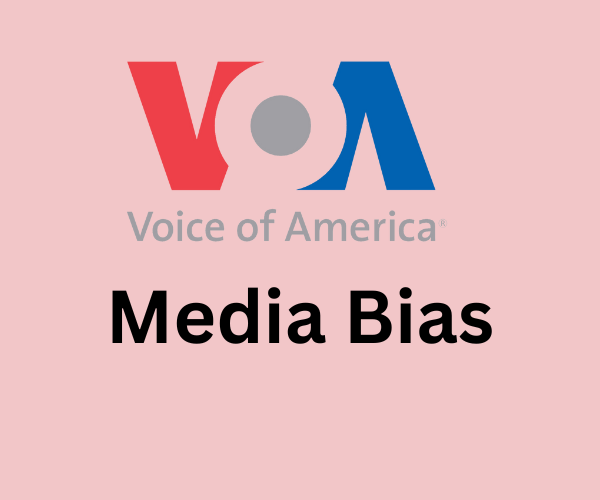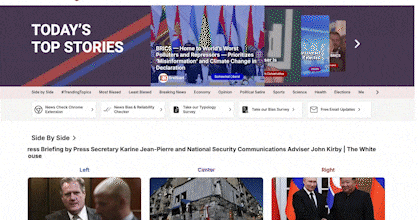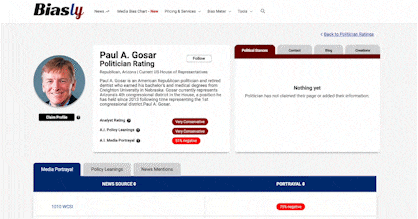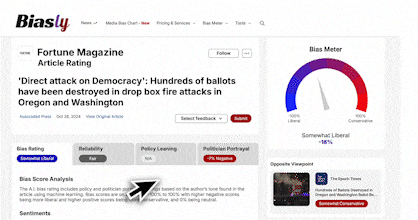
Voice of America was established in 1942, the publication mainly distributes articles, radio, and television programming globally, targeting a large international audience as they release their content in 48 different languages.
The agency is enveloped in an interesting history as it was established and continues to be funded by the United States government, leading to some individuals and groups questioning the integrity of the content it produces. According to Similar Web Voice of America received 9.7 million total visits in June 2024, making it a popular news source for many in the United States and around the globe.

Source: Pew Research
According to this Pew Research study, Americans feel as though the government is responsible for curbing the spread of misinformation and fake news. Voice of America is a news platform that the United States government funds, meaning they can influence at the very least their funding levels, or at most govern the content it produces, such as the integrated strategic counterterrorism communications initiative which affected the Voice of America’s parent agency. Considering these facts it is important to discern whether the publication is biased due to the government’s direct involvement in the agency’s operations.
How Does Biasly Rate News Sources?
Biasly’s algorithms produce bias ratings to help provide multiple perspectives on given articles. Biasly has analyzed 200,000+ news articles from more than 3,200 news sources through our A.I. technology and team of political analysts to find the most factual, unbiased news stories.
Biasly determines the degree of political bias in news sources by using Biasly’s Bias Meter Rating, in which Biasly’s team analyzes media sources’ reliability and bias and produces three scores, a Reliability Score that measures the accuracy of media sources; an A.I. Bias Score, evaluated by A.I.; and an Analyst Bias Score evaluated by political analysts. These scores are rated based on seven rating metrics including Tone, Tendency, Diction, Author Check, Selection/Omission, Expediency Bias, and Accuracy. These metrics help our analysts to determine the political attitude of the article.
Our A.I. machine-learning system employs natural language processing and entity-specific sentiment analysis to examine individual articles and determine their bias levels. By analyzing the key terms in an article such as policies, bias phrases, political terminologies, politicians, and their nicknames, the algorithms can rate the attitude of the text. Bias scores range from -100% and 100%, with higher negative scores being more liberal and higher positive scores being more conservative, and 0% being neutral.
Is Voice of America Politically Biased?
Biasly has given Voice of America a Computer Bias Score of Center-Left, this score is given based on A.I. algorithms. The AI analysis determines bias through the evaluation of authors’ tone, opinions, diction, and tendencies. For example, Biasly’s AI rated its leanings for the policies of government spending, abortion, affirmative action, and the border wall as Center, which means on average they report on these issues from a neutral perspective. Biasly also found that they cover politicians from both sides in a relatively balanced manner, for example, they covered both Republican Alex Azar and Democrat Alcee Hastings in a positive light.
Before we begin, we need to discuss bias. Bias is a natural function of humans, and we can express it both consciously and unconsciously. Bias is one of the most fundamental forms of pattern recognition in humans. This isn’t to lower the bar and say that “all things are biased,” but to explain how we may come to trust certain news organizations that display coverage patterns.
On the media’s part, there is an incentive to retain audiences, encourage them to purchase subscriptions, and rate products positively. Bias is a two-way street, people want to see news stories about things they care about, and the media needs viewers to continue their operations. This creates a positive feedback loop that influences what stories are covered and from what perspective. This also explains the actions of more liberal news organizations.
Analysis of Bias in Voice of America Online Articles
Having received a Score of Center-Left, Voice of America can generally be understood to publish stories that are relatively free of significant bias. However, in the case of individual articles, some may present more bias than others. This section will seek to understand whether bias exists within their fact-based articles.
To determine if bias is present there are a few factors that must be taken into account, these include Tone, Tendency, Diction, Author, and Expediency Bias.
One article, “Homeland Security Chief Cites Progress at US-Mexico Border”, describes the actions and resulting progress of policy changes the Biden administration made regarding the separation of children and parents at the Mexican border. This story rated as Somewhat Liberal according to Biasly maintains a slight liberal tone and tendency throughout.
An example of this tendency, or use of tone throughout the article, is through the use of sources:
“Mayorkas told U.S. lawmakers Thursday that the Biden administration has reduced the number of unaccompanied minors held at border stations from the thousands to the hundreds, and cut the average holding time from more than five days to less than 24 hours”
“Mayorkas said a sustained effort is needed because ‘surges arise periodically,’ and migration is a very dynamic and fluid challenge that we have faced for many, many years.”
While these quotes do not contain much outright bias by themselves they display a disparity in the sources used throughout the article, the author used liberal-leaning sources more than those with opposite viewpoints. This rift may lead the reader to engage more with the arguments Biden’s administration has made, rather than considering both sides of the issue equally.
In terms of diction, referring to the use of extreme language, or trigger words, the author does not make use of these within the article, in his paraphrasing, in addition to the author’s own words he did not use any of these biased words. One example of this is located in the conclusion of the article where the author states:
“Overall, the White House envisions a multibillion-dollar four-year effort to reduce the impetus of people from Guatemala, Honduras and El Salvador to migrate north”
She does not use any language that would taint the argument the Biden administration made regarding the policy changes and their effects.

Source: Voice of America
Expediency bias, or the use of titles or imagery to introduce bias, is somewhat relevant in this article. Although the image used below the headline of the article does not contain much bias, solely showing Homeland Security Secretary Alejandro Mayorkas testifying before a committee. The title, however, does contain bias as it could be misinterpreted as an overall reduction in illegal immigration since the specific issue of child separation was not mentioned. The word “progress” could also be misunderstood as a greater number than reality because the title does not reference specific metrics.
The author of an article has a significant impact on the amount of bias which can be seen throughout, one way to check if the author may be inclined to introduce bias into the articles they write can be looking into their past work or comments they make on other platforms. The author of this article, Aline Barros, on her X account often reposts liberal-leaning comments such as these:
“Rich Americans are reaping the rewards of soaring prices for stocks and houses as lower-income Americans struggle. Here’s why that divide is central to understanding the economy and politics of 2024”
“It’s become a common scene on the New York City trains and subway platforms as more than 195K migrants have made their way through city care since last spring: families and their children, offering candy to New Yorkers in transit across the city.”
It’s become a common scene on the New York City trains and subway platforms as more than 195K migrants have made their way through city care since last spring: families and their children, offering candy to New Yorkers in transit across the city.https://t.co/O8ymGPZzqO
— Documented (@Documentedny) June 29, 2024
Rich Americans are reaping the rewards of soaring prices for stocks and houses as lower-income Americans struggle.
Here’s why that divide is central to understanding the economy and politics of 2024. https://t.co/EuqmDkfQpV
— Axios (@axios) May 25, 2024
Although this article does contain some liberal bias, there are articles published on Voice of America that do not contain the same levels of bias, such as “Nauru Changes Diplomatic Recognition from Taiwan to China”. This story was Rated as Center according to biasly and does not contain any significant bias within the parameters discussed in this section.
Reactions to content published by an agency can also provide insight into potential bias, one example of this can be seen in Voice of America’s X profile where they post content regarding recently published articles and videos. In one post, promoting the article “Russia Hits Kyiv Children’s Hospital in Deadly Missile Attacks on Several Ukrainian Cities”, commenters reacted:
“Russians are monsters. Unfit to live in a civilized world.”
“Time to negotiate. Give them Ukraine so they won’t do it again?”
Russians are monsters. Unfit to live in a civilized world.
— Larry Rodrigue (@larry_rodrigue1) July 9, 2024
Time to negotiate. Give them Ukraine so they won’t do it again?
— Sasha Eberhard 🇺🇦 (@SashaEberhard) July 8, 2024
A variety of opinions in reaction to their content can indicate that the news source does not often placate a certain political base. Echo chambers are more prevalent now than ever, a userbase that holds largely similar points of view can be a signifier of this, and may also suggest that bias is present within their content. These comments above which largely hold a negative opinion regarding the actions of Russia may indicate an anti-Russian sentiment. Recognizing signs of bias such as through this method can be useful in seeking out quality news sources more effectively.
Analysis of Voice of America Opinion Articles
Opinion articles provide a framework for authors to discuss their perspectives and beliefs within a story. This type of article must be differentiated from traditional fact-based articles where it is expected the author remains free of bias. While opinion articles can contain valuable information, and provide a fresh perspective on an issue, it is helpful to understand that the content often contains far more bias than traditional fact-based reporting.

Source: Voice of America
The article “NATO Summit Marks 75 Years of Success” is an example where opinion articles can contain bias, as the title alone shows that the author clearly favors the actions that NATO has taken over the past 75 years. A title such as this can prime the reader to favor the points of the author and subsequent arguments regarding the actions of NATO.
However, there are some opinion pieces published by Voice of America that do not contain the same levels of bias, for example, the opinion article “2024 Trends in Trafficking” contains a title that does not boast the same levels of bias. This allows the reader to engage with the article from the beginning with a more neutral standpoint.
Who Owns Voice of America?
The United States Government funds Voice of America, and there have been calls of concern over time questioning the agency’s ability to remain neutral under such leadership.

Source: Wikipedia
Some protections are in place, however, which protect the publication from their content being directly impacted at the behest of whichever administration is in power at the time. The 1994 International Broadcasting Act put protections into law that enshrine freedom of objectivity towards Voice of America, allowing them to operate independently of bias. This legislation has seemed to stand the test of time as even today, 30 years after the law was introduced, Voice of America continues to remain relatively bias-free as corroborated by Biasly’s rating of Center-Left.
How to Evaluate and Uncover Bias
It can often be difficult to tell if the news you watch is biased. If you have settled on a news channel, it’s usually because you trust the information you are gaining. Unfortunately, many trust the information they are hearing because it confirms what they already believe. This is referred to as “confirmation bias.” It is important to challenge your beliefs and get third-party verification that what you are hearing is the full story. This is why we recommend using Biasly to compare different news stories side-by-side using our bias ratings to figure out what both sides think of a political issue.
Since Voice of America received a Bias Rating of Center-Left, it is generally safe to assume that most of the articles posted on the site do not contain significant bias. However, it is still important to understand that some individual articles, such as some discussed previously in this article, may contain differing levels of bias. It is helpful to remain cognisant of signs of bias, as it can help one gain the most accurate information possible. One more method that is helpful in this regard is using Biasly News Check which helps uncover any bias or reliability issues.

























